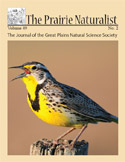Great Plains Natural Science Society

The Prairie Naturalist
Date of this Version
12-2009
Document Type
Article
Citation
The Prairie Naturalist· 41(3/4): December 2009, pp 131-132
Abstract
The winter range of North American short-eared owls (Asio flammeus) encompasses much of the United States, including southern Texas, where it is a common winter resident (Oberholser 1974, Rappole and Blacklock 1985). Winter food habits of short-eared owls are relatively weJl documented, but the majority of investigations have been conducted in eastern Canada and northeastern U.S. (Clark 1975, Holt 1993); midwestern U.S. (Colvin and Spaulding 1983); and British Columbia and Pacific northwestern U.S. (Bogiatto et al. 2001). The short-eared owl has a narrow trophic niche, generally preying on small mammals, with voles (Microtus spp.) and deer mice (Peromyscus maniculatus) usually reported as the most prevalent prey in North America (Holt and Leasure 1993). Only one study of short-eared owl food habits in Texas (Hogan et al. 1996) can be considered representative. Our objectives were to identify and enumerate mammalian prey in the winter diet of the short-eared owl in an area in southern Texas, and report two previously undocumented prey items in the diet of the short-eared owl.
Included in
Biodiversity Commons, Botany Commons, Ecology and Evolutionary Biology Commons, Natural Resources and Conservation Commons, Systems Biology Commons, Weed Science Commons

